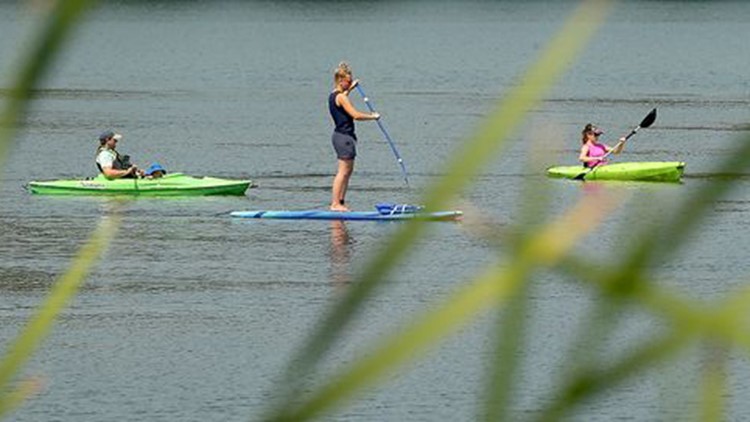PORT ORCHARD — Horseshoe Lake is an ideal place to cool down on scorching summer days.
The county park in South Kitsap offers shady trails, ample parking and a small but easy-to-access beach, drawing swarms of visitors on warm weekends.
"It's one of our most popular recreational swimming beaches in the area," Kitsap Public Health District's Jim Zimny said.
Horseshoe's popularity as a swimming hole has a downside. As dozens of visitors pack into the small swimming area, the potential for viral outbreaks increases.
139 possible norovirus cases under investigation
The lake has been linked to three such outbreaks in the past decade. Each occurred during hot weather, when lots of people were swimming.
Reports from the most recent round of illness began trickling in last weekend from people who'd swam at the lake and developed a gastrointestinal illness. Officials closed the lake as a precaution. By Friday, the health district was investigating 139 cases.
The source of the illnesses has not been confirmed by a laboratory, but symptoms are consistent with norovirus, according to the health district. The last norovirus outbreak originated at Horseshoe Lake in 2014, sickening nearly 300 people.
According to health officials, the outbreaks begin when one or several people infected with a virus decide to go for a swim. Those people — and this gets gross — then defecate or throw up in the water.
"Somebody likely had a diarrheal or vomiting event in the lake," Zimny summarized.
The virus spreads as other people swim or wade nearby and ingest water. Children frequently become ill by drinking lake water.
Viruses don't live long or transmit easily on lake surfaces, but when viral loads are high enough, and many swimmers squeeze into a small space, a virus can infect large groups. A norovirus outbreak in 2010 was traced back to a single child.
Simple steps, like showering thoroughly before and after swimming and not going to lakes or pools within days of being sick, can help prevent the spread of waterborne pathogens. People can help officials investigate health risks by reporting illnesses and water quality concerns like discolored water or odors.
"We can respond faster and we can protect public health better," health district spokeswoman Karen Bevers said.
Watching for warning signs
Viruses aren't the only potential health hazards lurking in lakes.
Health district employees monitor busy swimming beaches weekly during the summer to check for potential pathogens and issue advisories as needed. Common waterborne health risks fall into three broad categories:
Bacteria: The district samples for E.coli, an indicator that other bacteria that can cause disease are present in the water. Bacteria are always present in lakes, but when E.coli levels reach levels that indicate the water isn't safe for humans, the district will work with park management to close swimming in the area.
Bacteria that can make humans sick are frequently carried in by swimmers and pets. Dirty baby diapers are a common culprit.
The district has collected data on bacteria levels in lakes since the 1990s and found the busier the lake gets, the more bacteria is present in the water.
"As the number of people using a natural bathing beach goes up our bacteria load goes up," Zimny said. "It seems to be entirely dictated by the number of people."
A large flock of waterfowl on a lake can bump the bacterial load, Zimny added, "but there's not good science to support it being a source of disease for humans." Failing septic systems can also add bacteria, though the health district responds quickly to correct problem systems.
Viruses: Like harmful bacteria, viruses are carried into the water by swimmers and animals. Unlike bacteria, viruses aren't identified with routine water sampling, making it difficult for officials to warn the public when a risk is present.
"There's no easy, usable test of water in lakes that will check for viruses," said Grant Holdcroft, who oversees the health district's water pollution program identification and correction program.
Instead, the district aggressively investigates reports of illness from people who've swam at lakes. Stool samples are used to confirm viruses as the source of a sickness.
Cyanobacteria: Also known as blue-green algae, cyanobacteria refers to hundreds of species of naturally occurring organisms that bloom during warm months. The bacteria can produce a wide variety of toxins.
Neurotoxins generated by the blooms are potentially deadly and can have long-term health effects. When cyanobacteria warnings go up at lakes, as they did at Kitsap and Long Lakes this summer, people should stay out of the water.
"It's extremely important to take it seriously," Zimny said.
Unlike harmful bacteria and viruses, cyanobacteria reproduces naturally in lakes, though nutrients from human-generated pollution help feed the blooms. Phosphorous from fertilizer, stormwater runoff and activities like logging can promote blue-green algae growth.
'We are expecting to see more events'
"So is this going to happen every summer now?" is a common response to swimming advisories posted on social media.
The public may perceive that lakes are becoming more hazardous, Zimny said, but that trend isn't supported by water-monitoring data. Instead, he believes social media may make people more aware of closures when they happen and advances in water testing in recent decades have allowed public health officials to more accurately assess the risk of illness.
"We didn't have a lot of these tools in place when we got started," Zimny said.
Lauren Jenks, director of environmental public health sciences for the state Department of Health, said climate change is expected to produce more toxic events in lakes in the future.
Blue-green algae, for example, needs heat and nutrients to proliferate. As the planet warms, blooms will become more frequent and more toxic.
"We are expecting to see more events just like this," Jenks said.
For more information on lake advisories and tips for preventing illness, go to kitsappublichealth.org.



